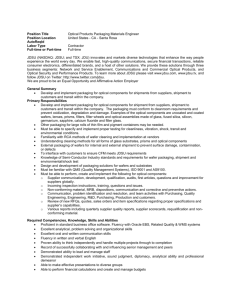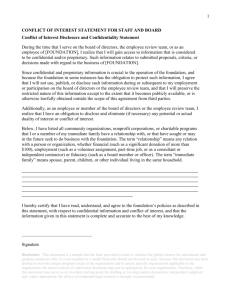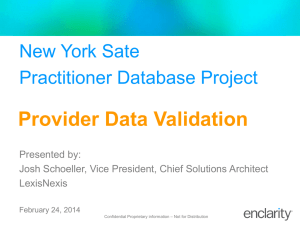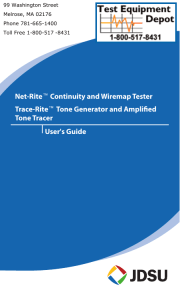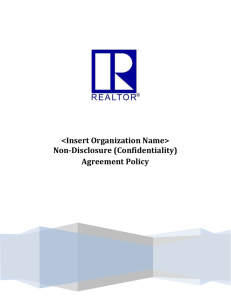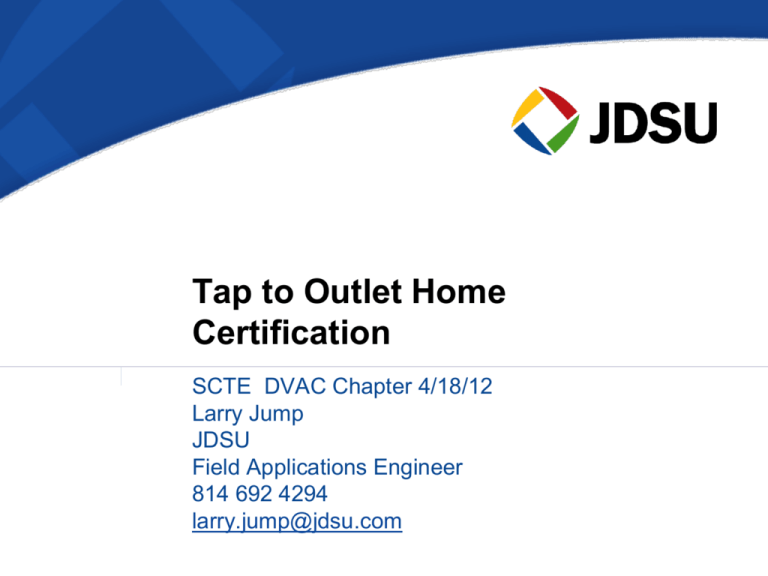
Tap to Outlet Home
Certification
SCTE DVAC Chapter 4/18/12
Larry Jump
JDSU
Field Applications Engineer
814 692 4294
larry.jump@jdsu.com
Today's Agenda
Home Certification Overview
– What is Home Certification?
– Why do we need it?
– What is the technology?
Certifying the Home
– Home Certification Challenges in the field
– What affects Services
– What can and should be done
Questions and Answers
2
© 2011 JDSU. All rights reserved.
JDSU CONFIDENTIAL & PROPRIETARY INFORMATION
Why Home Network Certification?
Estimated that 70-75% of all trouble calls are due to
problems inside the home.
Estimated that between 90-95% of troubleshooting root
cause of service issues inside a home is coax path related
– Replacing connectors, splitters, faulty coax, etc…
– Craftsmanship
– This is consistent with both QAM and MoCA services
QAM signals are more susceptible to issues
– QAM signals are maxed out
– Now more susceptible to other issues
Greater customer satisfaction through a more reliable
network
Home certification has been proven to reduce costly repeat
truck rolls.
3
© 2011 JDSU. All rights reserved.
JDSU CONFIDENTIAL & PROPRIETARY INFORMATION
Why should we do this “certification”?
The best answer is:
– to provide short and long term customer satisfaction
by:
• Reducing repeat visits
• Reducing overall truck rolls over time
• Reducing unnecessary Refer to Maintenance calls
» Providing test data to tech responding to
escalation
• Being prepared for future technologies
Another step closer to One and Done
4
© 2011 JDSU. All rights reserved.
JDSU CONFIDENTIAL & PROPRIETARY INFORMATION
Find and Fix Dilemma
• Missing marginal installations often leads to 3-1 find and fix scenario
$125 install tech
truck roll
$125 network tech $125 service
truck roll
tech truck roll
Field
Tech
Network
Tech
Field
Tech
• 3 truck rolls that should have only required 1, 3-1
• At $125/roll, cost for repair was $375 or $250 extra cost!
• At $100/month average customer revenue, and a 50% margin,
that means that about 5 months of profit are gone from this customer
• Saving only 1.5 - 2 events per month, pays for a field instrument
that can help prevent this scenario in less than 12 months.
5
© 2011 JDSU. All rights reserved.
JDSU CONFIDENTIAL & PROPRIETARY INFORMATION
What goes wrong?
Excessive attenuation caused by too many
splitters or long cable runs
A drop amplifier that does not pass the entire
required spectrum
Un-terminated splitters or outlets
Poor crimping or other connector issues
Cable faults or other conductor flaws
Many of these flaws are caused by poor
craftmanship!
6
© 2011 JDSU. All rights reserved.
JDSU CONFIDENTIAL & PROPRIETARY INFORMATION
Why do we need to certify the home?
Upcoming technologies will require an even more robust
home network.
MoCA supports a full-mesh network between all nodes,
procedures must be modified to rate all segments, not just
from the initial splitter to outlets but also STB-to-STB
segments that may not include the initial splitter.
Any number of components could be the cause, including
bad connectors and splitters, amplifiers, band pass filters,
un-terminated cables or excessive noise, distortion or
interference that affects the part of the spectrum.
7
© 2011 JDSU. All rights reserved.
JDSU CONFIDENTIAL & PROPRIETARY INFORMATION
Benefits of Certification
Customer doesn’t
call Boss
Boss doesn’t get
mad at tech
Tech doesn’t take
it out on dog
Happy Customers
Happy Boss
Happy Tech
8
© 2011 JDSU. All rights reserved.
JDSU CONFIDENTIAL & PROPRIETARY INFORMATION
Happy Dog
Find Root Cause of Service Issues
Troubleshooting Philosophy:
– Quickly find and fix the root cause of 80-90% of in-home
related issues – the Coax
– Allow operators to determine all Triple-Play & other
newer services will work before connecting any CPE
devices!
• Certify the home’s coax plant over all frequencies is
correct
• It doesn’t matter what service is running on the coax
• Future proof for eventual additional revenue
9
© 2011 JDSU. All rights reserved.
JDSU CONFIDENTIAL & PROPRIETARY INFORMATION
Why do we need to do this
Remember the Goal –
Help assure that work (service, install, etc.) is done
correctly the first time, and verified with quantitative test
data, hence reducing repeat service calls.
You can ensure that the proper tests are taken for every
required job and the test data is recorded.
Testing is consistent across all techs and jobs
– Test data is reconciled against the work order system
Quality standards are enforced for each job
10
© 2011 JDSU. All rights reserved.
JDSU CONFIDENTIAL & PROPRIETARY INFORMATION
What is Home Cert?
Testing
– Tap to TV, Modem, or Set Top Box
• The span of the network the Service /Install Tech controls.
• Using the test equipment provided
Standardization
• All customers get the same tests
All Techs run the same tests
• Apple to Apples
Verification
– Ensure that the testing was done correctly
Assurance
– Ensure that corrective action is taken if required
Reporting
– Provide compliance information to managers and technicians
Data Collection
11
© 2011 JDSU. All rights reserved.
JDSU CONFIDENTIAL & PROPRIETARY INFORMATION
Why this, instead of other back office tools?
Because you are the one with the tool belt
Because you can move the test equipment around while you
troubleshoot.
– Outlet to Ground Block to Tap
Know at once when you have fixed, or found the location of
the problem
Provide measurement history at that location for future
reference.
12
© 2011 JDSU. All rights reserved.
JDSU CONFIDENTIAL & PROPRIETARY INFORMATION
Summary so far
Run the tests at jobs that require a test to be run
– Results are compared to user defined Pass/Fail limits
– Pass/Fail limits should be such that a fail means “must fix”
Fix problems uncovered
– Or validate they need escalation ( via test at Tap)
Re-run test to verify correction of problems
Results are reported in terms of number of tests:
– that actually were performed versus number that SHOULD have
been performed
– Number of tests passed
Reporting is available grouped by System, Manager,
Supervisor, or Technician.
Goal is to achieve and maintain high compliance and passing
numbers
13
© 2011 JDSU. All rights reserved.
JDSU CONFIDENTIAL & PROPRIETARY INFORMATION
By successfully implementing Home Certification
• Reduce repeat rate – lowering repeats caused by marginal signal
conditions
• Create a system wide standard for acquiring & interpreting test
results
Results in standard and consistent procedures that ensure
quality based on quantitative test data
• Improve productivity by reducing repeat service calls
• Improve customer satisfaction levels, as customers do not have to
keep experiencing the same problem
• Provide a central repository for test data provides management
reports, trends for data analysis, efficiency of technician and
productivity
14
© 2011 JDSU. All rights reserved.
JDSU CONFIDENTIAL & PROPRIETARY INFORMATION
Reports
15
© 2011 JDSU. All rights reserved.
JDSU CONFIDENTIAL & PROPRIETARY INFORMATION
System Workflow Diagram
Daily electronic
file with Work
Order
Information
from billing
system
TPP Relational
Database
Web Server
Save test files
taken at jobs
into Folders
Management Reports
16
© 2011 JDSU. All rights reserved.
JDSU CONFIDENTIAL & PROPRIETARY INFORMATION
Test Result Queries
Another view
TAP
Drop CableHouse
OLDER
TV SET
DIGITAL
SET-TOP
GROUND 2-Way High
BLOCK Amplifier Pass
Filter
Stores test data,
Compares test
from meter with
workorderdata
TPP Relational
Database
17
© 2011 JDSU. All rights reserved.
COMP
Digital Voice
UTER
ETHERNET
Work Order
File from
Workorder info
from Billing Billing
System
System
Web Server
JDSU CONFIDENTIAL & PROPRIETARY INFORMATION
How Work Orders are matched with Test Results
CSG, DST, ICOMSs, Custom
– Minor differences between vendors
Information in Work Order File:
– assigned Tech, Work Order Type, job number, account number,
completion codes, job status, and completion date, Node, system
ID, etc.
Meter saves test named as account number or Job Number
Information from meter(saved tests):
– Tech ID, Account Number or Job Number, Date/Time Saved,
and of course, the test measurement data
Test
Data
18
© 2011 JDSU. All rights reserved.
Server:
Application and
Database
JDSU CONFIDENTIAL & PROPRIETARY INFORMATION
Work
order
Info
Meter Synchronization Process
• Synchronization (upload) process allows tech to send
data back to the server
• Also allows channel plans, test plan setup and ,
limit plans to be sent to the meter.
• Assure all meters use proper settings
• Connect via the RF plant (DOCSIS channel) or
Ethernet LAN, or available wireless networks.
• The Certification test data is sent back and saved in
Application Database and the Certification Reports are
created from this database
2-way communication
RF, Wireless, or Ethernet
19
© 2011 JDSU. All rights reserved.
JDSU CONFIDENTIAL & PROPRIETARY INFORMATION
Server:
Application and
Database
Testing RF networks in the Home
TAP
House
Drop Cable
OLDER TV SET
DIGITAL SET-TOP
COMPUTER
GROUND
BLOCK
2-Way
Amplifier
Digital Voice
High Pass
Filter
ETHERNET
3-Way
Splitter
eMTA-CABLE MODEM
20
© 2011 JDSU. All rights reserved.
JDSU CONFIDENTIAL & PROPRIETARY INFORMATION
ONLINE GAMING
The Basics…..Where
TAP
Drop CableHouse
OLDER
TV SET
DIGITAL
SET-TOP
GROUND 2-Way High
BLOCK Amplifier Pass
Filter
COMP
Digital Voice
UTER
ETHERNET
Which outlet should we test?
Pretty much common sense
-Voice
-Data
-Largest TV
21
© 2011 JDSU. All rights reserved.
JDSU CONFIDENTIAL & PROPRIETARY INFORMATION
The Basics…What do we test – RF Layer
Downstream RF
–
–
–
–
–
–
–
Level
C/N ( Analog – Remember Analog?)
Hum ( Analog – yep, still around, sometimes)
Video/Audio Carrier Delta ( difference)
MER
BER
(Drop Frequency Response)
Upstream RF
– Upstream Tx Level
– Upstream Tx Headroom
22
© 2011 JDSU. All rights reserved.
JDSU CONFIDENTIAL & PROPRIETARY INFORMATION
What is Comcast doing now?
23
© 2011 JDSU. All rights reserved.
JDSU CONFIDENTIAL & PROPRIETARY INFORMATION
The Basics…What do we test - DOCSIS
Downstream
–
–
–
–
Level
MER
BER
Registration
• Configuration file, Gateway IP, Modem IP, BPI Status
• DOCSIS 3 Bonding
Upstream
–
–
–
–
24
Channel assignment and Bonding
Packet Loss
Throughput ( Speed)
VoIPcheck – simulated Digital Voice Packets
© 2011 JDSU. All rights reserved.
JDSU CONFIDENTIAL & PROPRIETARY INFORMATION
Typical Ingress Test
25
© 2011 JDSU. All rights reserved.
JDSU CONFIDENTIAL & PROPRIETARY INFORMATION
25
What do we test - Ingress
Ingress can be included
as one of the Home
Certification tests
Can be run before or
after the inside the home
test
Attic
POTS
3
1
5
26
© 2011 JDSU. All rights reserved.
2
4
JDSU CONFIDENTIAL & PROPRIETARY INFORMATION
Testing the Home for Ingress Contribution
7 dB TAP
Return
Equalizer
Drop Cable
Disconnect drop from tap
and check for ingress
House
coming from customer’s
home wiring
OLDER TV SET
WIRELESS LAPTOP
DIGITAL SET-TOP
If ingress is detected at tap
end, repeat at ground block
to localize
COMPUTOR
GROUND
BLOCK
2-Way
Amplifier
VoIP
High Pass
Filter
ETHERNET
3-Way
Splitter
eMTA-CABLE MODEM
INGRESS SPECTRUM MEASUREMENTS
27
© 2011 JDSU. All rights reserved.
JDSU CONFIDENTIAL & PROPRIETARY INFORMATION
ONLINE GAMING
Troubleshooting Tests
What other tests does the tech have to
troubleshoot if there is a problem:
–
–
–
–
28
DQI
QAM Ingress
DOCSIS Tests
Smart Scan
© 2011 JDSU. All rights reserved.
JDSU CONFIDENTIAL & PROPRIETARY INFORMATION
Measurements over time
29
© 2011 JDSU. All rights reserved.
JDSU CONFIDENTIAL & PROPRIETARY INFORMATION
29
Ingress under QAM Measurements
30
© 2011 JDSU. All rights reserved.
JDSU CONFIDENTIAL & PROPRIETARY INFORMATION
30
Smart Scan
31
© 2011 JDSU. All rights reserved.
JDSU CONFIDENTIAL & PROPRIETARY INFORMATION
DOCSIS Measurements
32
© 2011 JDSU. All rights reserved.
JDSU CONFIDENTIAL & PROPRIETARY INFORMATION
32
Test setup configuration – Video Tests
33
© 2011 JDSU. All rights reserved.
JDSU CONFIDENTIAL & PROPRIETARY INFORMATION
Test setup configuration –
Modem/DOCSIS tests
34
© 2011 JDSU. All rights reserved.
JDSU CONFIDENTIAL & PROPRIETARY INFORMATION
Test setup configuration – Ingress setup
35
© 2011 JDSU. All rights reserved.
JDSU CONFIDENTIAL & PROPRIETARY INFORMATION
Limit ( Pass/Fail) Values
Can be set for up to 8 locations
36
© 2011 JDSU. All rights reserved.
JDSU CONFIDENTIAL & PROPRIETARY INFORMATION
Understand the results screen – and act on what it
tells you….know what failed and why
37
© 2011 JDSU. All rights reserved.
JDSU CONFIDENTIAL & PROPRIETARY INFORMATION
Certification: The tech needs to know how to…..
•Know which job types to test
•Know which outlet to test
•Know which channel plan is the right one to use
•Know how to name and save the test
•Know how to understand what failed, if there is a fail
•Know how to fix or report what failed, know how to
escalate and verify why that escalation is needed.
•Know how and when to synchronize the meter with the
server.
38
© 2011 JDSU. All rights reserved.
JDSU CONFIDENTIAL & PROPRIETARY INFORMATION
New and upcoming?
MoCA
WiFi
DNLA
39
© 2011 JDSU. All rights reserved.
JDSU CONFIDENTIAL & PROPRIETARY INFORMATION
MoCA Parameters
MoCA uses the existing coaxial cable plant in a
subscriber’s home as the connecting media for devices
on a home network.
MoCA 1.1 provides a 16-node solution
175 Mbps will always be available to more than 95
percent of the nodes
BER target of 1 x 10-9.
Communication between devices on a MoCA network is
controlled by a node designated as the network
coordinator (NC)
Nodes need to be able to transmit RF carriers at 55
dBmV to overcome splitter port to port isolation.
Sometimes 2 splitters.
40
© 2011 JDSU. All rights reserved.
JDSU CONFIDENTIAL & PROPRIETARY INFORMATION
An In-Home Network, Physical Layer
Splitter
Splitter
Attic
NC
Crawl Space
41
© 2011 JDSU. All rights reserved.
JDSU CONFIDENTIAL & PROPRIETARY INFORMATION
MoCA Node Discovery
A node joins a MoCA network by listening for a
beacon signal from the NC
After receiving the beacon signal, a new node
sends an admission request to join the network.
If no beacon is heard, the new node assumes it is
the first and begins transmission of its own beacon.
MoCA 1.1 completes the probe and beacon tasks
faster than its predecessor MoCA 1.0. This allows
an increase in the maximum number of nodes from
eight to 16 and provides a throughput increase
from 100 to 175 Mbps network throughput for 95
percent of the nodes.
42
© 2011 JDSU. All rights reserved.
JDSU CONFIDENTIAL & PROPRIETARY INFORMATION
MoCA Optimization
In addition to cable, the subscriber’s plant also contains splitters and
sometimes amplifiers. MoCA equipped devices also need to be able
to communicate through high-isolation output ports, in the forward as
well as reverse directions.
This is accomplished using a form of orthogonal frequency division
multiplexing (OFDM) that is dynamically tailored to the individual
paths in the subscriber’s coax network.
“Probe” signals are periodically sent to the MoCA nodes on the plant
to determine frequency response at each of the OFDM subcarrier
frequencies.
The optimal combination of constellation and frequency for each
node is determined to achieve a BER of 1 x 10-9, resulting in
constellations that can range from no symbols to 256-QAM
Because the electrical characteristics of the plant can change when
the subscriber adds or removes devices, probes are sent on a
periodic basis, and the OFDM scheme is changed as required.
43
© 2011 JDSU. All rights reserved.
JDSU CONFIDENTIAL & PROPRIETARY INFORMATION
MoCA 1.1Physical Layer
Operates between 850 and 1525 MHz
Each channel is 50 MHz wide in 1.1 or 100 MHz wide in 2.0
In some cases, more than 1 channel is used at the same time
to allow transport of 2 different logical networks.
44
© 2011 JDSU. All rights reserved.
JDSU CONFIDENTIAL & PROPRIETARY INFORMATION
44
MoCA Frequency Allocations
MoCA 1.x Frequency View
Downstream
Range
Upstream
Range
5 – 45
MHz
5 MHz
MoCA 1.x
Range
850 – 1525 MHz
55 – 1000 MHz
55 MHz
1 GHz
1.7 GHz
50 MHz
MoCA 2.0 Frequency View
Upstream
Range
5 – 45
MHz
5 MHz
Downstream
Range
MoCA 2.0
Range
500 – 1650 MHz
55 – 1000 MHz
55 MHz
1 GHz
1.7 GHz
100 MHz
45
© 2011 JDSU. All rights reserved.
JDSU CONFIDENTIAL & PROPRIETARY INFORMATION
MoCA MAC Layer
The NC determines how the nodes gain access the
network to transmit and receive Ethernet frames.
2 types of MAC layer frames
– Control frames contain management messaging
• Bandwidth requests
• Media Access Plans MAPs
– Data frames contain the end user application data
46
© 2011 JDSU. All rights reserved.
JDSU CONFIDENTIAL & PROPRIETARY INFORMATION
46
In-Home Logical Layer Diagram
Attic
Node A
Node B
NC
Crawl Space
47
© 2011 JDSU. All rights reserved.
JDSU CONFIDENTIAL & PROPRIETARY INFORMATION
47
MoCA 2.0 Details
MoCA 2.0 (June 15, 2010) - Similar to MoCA 1.1 but with the following
differences:
– Three new modes of operation:
• Basline Mode:
NOTE: MoCA 2.0 is different hardware
than previous MoCA 1.1 HW versions
– 400+ Mbps MAC throughput
– 700 Mbps PHY Rate
– Single 100 MHz Channel
• Enhanced Mode
– 800+ Mbps MAC throughput
– 1.4 Gbps PHY Rate
– Two bonded 100 MHz Channels (“Channel Bonding”)
• “Turbo” mode for a point-to-point configuration that allows:
– 500+ Mbps MAC throughput between two connected devices when operating in
Baseline mode
– 1+ Gbps MAC throughput when operating in Enhanced mode
– All three modes now have an extended frequency range
• 500 MHz through 1650 MHz (center frequencies)
– Backward compatibility with MoCA 1.0 and 1.1 devices
• MoCA 2.0 devices can operate at MoCA 2.0 speeds while MoCA 1.x devices are
communicated to at their maximum respectable speeds on the same network
48
© 2011 JDSU. All rights reserved.
JDSU CONFIDENTIAL & PROPRIETARY INFORMATION
What does the future hold for home networks?
WiFi has already surpassed wired in home networks
– Apple sold 3 million IPads within the 1st 3 months of it’s release
– There are now approximately 108 million IPhones worldwide
While WiFi is widely used for data, up until now it has been deemed
not reliable enough for video due to interference from such things as
microwave ovens and cell phones.
802.11n now provides for data rates up to 600Mbs on a 40MHz wide
carrier
802.11n also provides for the concept of multiple input multiple
output (MIMO), providing for a maximum of four transmit antennas
and four receive antennas.
802.11n also provides for Dynamic digital beamforming,it monitors
and adjusts the Wi-Fi signals based on real-time events that could
affect performance. In combination with the 4 x 4 antenna scheme,
beamforming can provide a 12dB-to-25dB improvement in reliability
With these 2 innovations, video can now be delivered reliably over
wireless
49
© 2011 JDSU. All rights reserved.
JDSU CONFIDENTIAL & PROPRIETARY INFORMATION
49
More not too distant future stuff, DLNA
Digital Living Network Alliance (DLNA) promotes wired and
wireless interoperability of PCs, CEs, and mobile devices.
A DLNA device works like any other network device by discovering
other DLNA-enabled hosts.
It learns their capabilities and exposes these features on the
device's control display.
Through DLNA, a media server can be located and then
summoned to play or display a stored family photo, movie, music
file, etc.
DLNA-certified devices include TVs, PCs, set-tops, routers, game
consoles, tablets, Blu-ray and DVD players, smartphones and
audio receivers.
The organization says it has certified more than 9,000 different
devices.
More than 440 million DLNA-certified devices were installed in
users’ homes by the end of 2010
50
© 2011 JDSU. All rights reserved.
JDSU CONFIDENTIAL & PROPRIETARY INFORMATION
50
A Wireless In-Home DNLA Network
Wireless Router
Splitter
Crawl Space
51
© 2011 JDSU. All rights reserved.
JDSU CONFIDENTIAL & PROPRIETARY INFORMATION
Now – what are we NOT doing?
We are NOT certifying the whole house (just yet)
We ARE certifying an outlet
– Which is way better than not certifying anything
The big reasons we don’t certify ALL outlets now
is…….
– We don’t know how many there are
– We don’t want to spend the time doing all outlets
• 2-3 minutes per outlet, plus ingress scan, plus
time to save, etc.
52
© 2011 JDSU. All rights reserved.
JDSU CONFIDENTIAL & PROPRIETARY INFORMATION
To completely verify the home network we would need to ….
•Verify signal quality at the Ground Block or Point of Entry
•Verify wiring from POE to each outlet
Loss
Noise/Ingress of each leg
Frequency response of each leg
•If we meet specs at the POE and verify wiring performance
from POE to outlet….then
•We don’t need to run RF/MODEM tests at each outlet, do
we?
53
© 2011 JDSU. All rights reserved.
JDSU CONFIDENTIAL & PROPRIETARY INFORMATION
Point of Entry (POE) Filter and Splitter Isolation
A MoCA filter (aka: POE filter) performs two jobs.
– First it prevents the MoCA signal from entering a neighbors house
by placing a filter at the input to the home network
– Second it gives MoCA a point of reflection for the signal because it
requires the signals to bounce from output port to output port.
There is approximately 30 dB of port to port isolation on a 2 way splitter
MoCA/POE
Filter
55 dBmV in
POE
30 db down from one
port to the other
25 dBmV out
54
© 2011 JDSU. All rights reserved.
JDSU CONFIDENTIAL & PROPRIETARY INFORMATION
What if……we could test multiple outlets…at
once?
TAP
Splitter
Attic
We could do all our up and
downstream tests at the
Ground block…
Splitter
X
Crawl Space
…And then verify that we
had good performance
from the ground block to
each outlet?
With 1 button push?
55
© 2011 JDSU. All rights reserved.
JDSU CONFIDENTIAL & PROPRIETARY INFORMATION
Mini-Probes…
Each probe :
• has an F-Connector and a mini-USB port
• its own unique identifier letter ( A, B, C, D, etc)
• Sweeps 5-1500 Mhz – forward and reverse
•Has FDR function to determine distance to faults
•Has noise detection to listen for and detect ingress
Meter connects to one probe via USB, and controls test and
displays results on screen.
56
© 2011 JDSU. All rights reserved.
JDSU CONFIDENTIAL & PROPRIETARY INFORMATION
Probe Setup
Splitter
USB to
Mini-USB
Attic
Point of Entry
or Main Split
Splitter
Crawl Space
Put a probe at each location inside the home where a Set-topbox or Cable Modem will be located (or is desired to be
tested)
Connect that probe to the POE looking into the home toward
CPE (ie: drop cable, ground block, or main split)
Connect the probe to the meters USB port
57
© 2011 JDSU. All rights reserved.
POE = Point of Entry
CPE = Customer Premise Equipment
JDSU CONFIDENTIAL & PROPRIETARY INFORMATION
57
We want to ….
Verify Frequency Response to and from each outlet
• So lets sweep forward and reverse from 5 Mhz to 1500Mhz
Calculate loss from Ground Block to each outlet
Listen for ingress on each leg
• With some built in intelligence we can map the wiring system too!
58
© 2011 JDSU. All rights reserved.
JDSU CONFIDENTIAL & PROPRIETARY INFORMATION
Sweep Trace – Freq Response
Shows POE to outlet frequency response for Forward and
Reverse Sweeps
Why not do 5-1500 in one sweep?
We want good resolution at the reverse band edges
Upstream Freq Response
59
© 2011 JDSU. All rights reserved.
Downstream Freq Response –
with MoCA filter in place
JDSU CONFIDENTIAL & PROPRIETARY INFORMATION
59
See each path’s frequency response
Sweep graphs can identify many issues in the coax network
– Relative levels are shown at multiple frequencies to give users
more information than numbers alone can express
• By looking at the sweep response users can identify why the
test failed the limits of the service plan:
– Too much overall loss, adjacent points’ difference too
great, overall highest loss to lowest loss (peak to valley)
too great
– Users can see and interpret from the sweep response signal
degradation caused by:
• Frequency cut offs due to poor splitters or inline filters
• Amplifiers eliminating the return or MoCA bands
• Excessive attenuation
• Reoccurring standing waves
• Frequency suck outs
60
© 2011 JDSU. All rights reserved.
JDSU CONFIDENTIAL & PROPRIETARY INFORMATION
60
Seeing how everything is connected
Shows what is connected
– The probes should determine how what it sees is connected and
where those elements have common connections
– Each element can be shown on the topology map including:
splitters, filters, amplifiers, and found mismatches
– Users can easily identify if unexpected elements are discovered
and trace where those elements are located before beginning to
troubleshoot the coax network
Note: Not every topology can be mapped with
100% accuracy though most common
configurations can. Filters and amplifiers in the
path can lead to inaccurate common points being
shown on the topology map and are highlighted
yellow when present.
61
© 2011 JDSU. All rights reserved.
JDSU CONFIDENTIAL & PROPRIETARY INFORMATION
61
Run to run details
62
© 2011 JDSU. All rights reserved.
JDSU CONFIDENTIAL & PROPRIETARY INFORMATION
Whole home results screen…
For whole house certification – Keep It Simple
Summary results has all that is needed at a glance:
– Pyramid screen
– Overall pass/fail
– Pass/fail for each upstream and downstream path from POE to
each outlet
– Ingress noise limit check
– Pass/fail for MoCA (if desired) between all devices in the
customer premise
63
© 2011 JDSU. All rights reserved.
JDSU CONFIDENTIAL & PROPRIETARY INFORMATION
Now – we have whole house Home Certification !
We can test RF downstream and upstream and DOCSIS at
the ground block or point of entry, and then…
We can test multiple outlets and know how many were tested
–
–
–
–
One-Button test for all tested outlets saves time
Identify what the inside wiring problem is
Identify where the problem is
Identify hidden amps, splitters and filters
True “Whole House” Certification.
64
© 2011 JDSU. All rights reserved.
JDSU CONFIDENTIAL & PROPRIETARY INFORMATION
Don’t have regrets…..Certify the home!
65
© 2011 JDSU. All rights reserved.
JDSU CONFIDENTIAL & PROPRIETARY INFORMATION
Thank you!
Tech Support and information Web Page
WWW.CATVSUPPORT.COM
66
© 2011 JDSU. All rights reserved.
JDSU CONFIDENTIAL & PROPRIETARY INFORMATION
Extra Slides
Well, we start off with the basics
68
© 2011 JDSU. All rights reserved.
JDSU CONFIDENTIAL & PROPRIETARY INFORMATION
68
1 Drop – 1 Node –
DO NOT NEGLECT DROP INGRESS MITIGATION!!
In-Band Power
10.393 dBmV
40
30
20
10
0
-10
-20
-30
-40
-50
-60
Span: 40.000 M Hz
RBW: 300 KHz
Center: 25.000 M Hz
VBW: 100 KHz
In-Band Power
Dwell: 400 µS
8.632 dBmV
40
30
20
10
0
-10
-20
-30
-40
•Reverse Spectrum shot at customer's drop
-50
-60
69
Span: 40.000 M Hz
RBW: 300 KHz
Center: 25.000 M Hz
VBW: 100 KHz
© 2011 JDSU. All rights reserved.
Dwell: 400 µS
JDSU CONFIDENTIAL & PROPRIETARY INFORMATION
Troubleshooting MoCA
MoCA emulation is currently not solving service problems
– Rate Tables between MoCA devices are already available via
diagnostic pages on STB’s (CPE)
– Rate Tables only provide techs with information of whether the
MoCA problem still exists or not
• Does not provide root cause breakdown or fault identification
• Tech must guess as to what is causing the MoCA issue by visually
tracing the coax, making changes, then retesting
Like DOCSIS – MoCA has been revised – Latest is MoCA
2.0 (Released June 2010)
– All devices today are still on the MoCA 1.1 chipset hardware
– New Hardware will be required to go to MoCA 2.0 – NOT a software
upgrade
– Most Operators will want MoCA 2.0 hardware when available in
mass deployments
• Capacity gains ensure future functionality support is easier to
deploy
• No chipsets/hardware currently exists for MoCA 2.0
70
© 2011 JDSU. All rights reserved.
JDSU CONFIDENTIAL & PROPRIETARY INFORMATION
JDSU SmartID™ - Advanced Coax Probes
Operator Issues:
Supervisors – Concerned when subscribers complain due to issues arising
shortly after an installation or the first/second repeat truck roll
Technicians – Much of their time spent troubleshooting coax cable attempting to
guess at possible solutions
MoCA – A new technology to the industry, therefore there is fear about the
unknown and how to fix issues when they appear
JDSU Solution with SmartIDs:
Reduce largest cause of service repeat tickets
– Increase Triple-Play and/or Multi-room DVR subscriber
satisfaction through reduced repeat calls
– Speedup troubleshooting by knowing what to fix
– Qualify the coax is capable of handing all services, present
and future
– Saves operators money by combining with existing DSAMs
and making techs more efficient
– Differentiate between Triple-Play or MoCA impairments
71
© 2011 JDSU. All rights reserved.
JDSU CONFIDENTIAL & PROPRIETARY INFORMATION
MoCA CPE Diagnostics Information
Good for verifying if MoCA rates are acceptable or failing
Troubleshooting problems with MoCA equipment
– Identifies which nodes it can not see
– Can identify a problem exists (Tiling, Rate issues, MER, BER, etc…)
– Rate Table does not help identify root cause of problems but
identifies which leg problems may exist
MAC Addresses
Rate Table
72
© 2011 JDSU. All rights reserved.
JDSU CONFIDENTIAL & PROPRIETARY INFORMATION
Complete in home certification
Splitter
USB to
Mini-USB
Attic
Point of Entry
or Main Split
Splitter
Crawl Space
73
© 2011 JDSU. All rights reserved.
JDSU CONFIDENTIAL & PROPRIETARY INFORMATION
Certify each Coax Path Independently
Qualification Screen shows Pass/Fail
– If all metrics pass the coax paths are good for the
services its was tested against
– If a failure exists then further action is required
• The columns on the left indicate which parameters failed for the
movable bold box – Different paths may have different results
• Additional detail about the failure can be collected from the
Detail and the Network Overview screens – Accessible by
pressing View
• A frequency response graph can be used to help determine
why the result was failing the limits set by the test
74
© 2011 JDSU. All rights reserved.
JDSU CONFIDENTIAL & PROPRIETARY INFORMATION
Seeing how everything is connected
Network Overview shows what is connected
– The SmartIDs can determine what it believes is
connected and where those elements have common
connections
– Each element is shown on the topology map
including: splitters, filters, amplifiers, and found
mismatches
– Users can easily identify if unexpected elements are
discovered and trace where those elements are
before beginning to troubleshoot the coax network
Note: Not every topology can be mapped with
100% accuracy though most common
configurations can. Filters and amplifiers in the
path can lead to inaccurate common points being
shown on the topology map and are identified
when present.
75
© 2011 JDSU. All rights reserved.
JDSU CONFIDENTIAL & PROPRIETARY INFORMATION
Deeper Dive into the Network
Detail view shows additional information about
the network
– Probe paths are isolated for a deeper view about the
tested coax network
– Individual coax segment information is shown –
Lengths and element information are indicated
– Additional text is presented to help indicate failed
service tests
– Elements such as filters, amplifiers,
– Potential
causes
the failures
and impedance
and splitters
are alsoofshown
with more
detail in this view
mismatches
are shown on the screen as faults
(exclamation points) as well as the distance from
other elements to the potential faults are shown
76
© 2011 JDSU. All rights reserved.
JDSU CONFIDENTIAL & PROPRIETARY INFORMATION
See each path’s frequency response
Sweep graphs can identify many issues in the
coax network
– Relative levels are shown at multiple frequencies to
give users more information than words alone can
express
• By looking at the sweep response users can identify why the
test failed the limits of the service plan
– Users can see and interpret from the sweep response
signal degradation caused by:
•
•
•
•
•
77
Frequency cut offs due to poor splitters or inline filters
Amplifiers eliminating the return or MoCA bands
Excessive attenuation
Reoccurring standing waves
Frequency suck outs
© 2011 JDSU. All rights reserved.
JDSU CONFIDENTIAL & PROPRIETARY INFORMATION
Lets have some review of MER…
“MER” is to Digital, what
signal to noise is for
analog
MER is affected by high
noise, low signal
78
MER readings are relatively
immune to “brief bursty”
interference
MER is a predictor of BER
© 2011 JDSU. All rights reserved.
256 QAM needs 29dB or
better to work.
64 QAM needs 25dB or
better to work.
– Also ANY other
impairments
40db is the highest you will
see.
Add 3db to above figures to
allow headroom.
JDSU CONFIDENTIAL & PROPRIETARY INFORMATION
78
Lets Talk a little BER
•BER responds to changes a faster than MER
•BER is ESTIMATED
•Its not like BERT testing where data is looped back
• A 256QAM channel transmits at a symbol rate of 5M symbols per second
• Bit rate = 8 bits per symbol X 5M symbol per second =40M bits per second
• Error Incident = Bit rate X BER = Errors Per Second
BER
10-12
10-11
10-10
10-9
10-8
10-7
10-6
10-5
10-4
10-3
79
Error Frequency
1 in 1 Trillion bits
1 in 100 Billion bits
1 in 10 Billion bits
1 in 1 Billion bits
1 in 100 Million bits
1 in 10 Million bits
1 in 1 Million bits
1 in 100 Thousand bits
1 in 10 Thousand Bits
1 in 1 Thousand bits
© 2011 JDSU. All rights reserved.
Error Incident
25000 secs between errs (6.94 hrs)
2500 secs between errs (41.67 mins)
250 secs between errs (4.167 mins)
25 seconds between errors
2.5 seconds between errors
4 errors per second
40 errors per second
400 errors per second
4000 errors per second
40000 errors per second
JDSU CONFIDENTIAL & PROPRIETARY INFORMATION
79
MER and BER Cliff Effect
1.10-1
A small variation
in MER (+/- 1 dB)
will cause a
large variation in
BER
measurement.
Using BER for
trouble-shooting
and fault
location is not
repeatable and
very inaccurate.
BER
4QAM
16QAM
64QAM
256QAM
4.10-4
1.10-9
2
80
© 2011 JDSU. All rights reserved.
23.5
MER
JDSU CONFIDENTIAL & PROPRIETARY INFORMATION
40
80
Testing multiple outlets in less steps
TAP
House
Drop Cable
Test RF
quality,
upstream
levels, DOCSIS
test here
Then verify
we can
deliver that
quality from
here to each
outlet
2-Way
Amplifier
GROUND
BLOCK
High Pass
Filter
3-Way
Splitter
eMTA-CABLE MODEM
81
© 2011 JDSU. All rights reserved.
JDSU CONFIDENTIAL & PROPRIETARY INFORMATION

